Chinese OEMs’ telematics research: high computing power chips promote the integration of telematics with AI
In the first eight months of 2021, 57.1% of new passenger cars in China installed telematics systems, 4.6 percentage points higher than in the same period of the previous year, of which Chinese brand passenger cars boasted a 59.6% installation rate, up 1.2 percentage points.
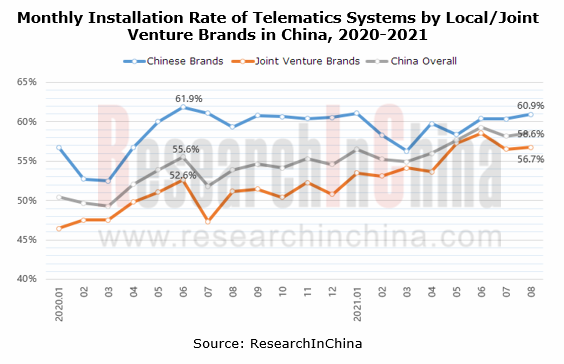
The steadily rising penetration of telematics systems in Chinese brands is benefited from the launch of intelligent platforms and creation of high-end intelligent brands, as well as close collaborations between industry chain partners. ResearchInChina surveyed that in the first eight months of 2021, all the homegrown high-end brands like Geely Lynk & Co, Great Wall WEY, Great Wall Tank, SAIC R CAR, Dongfeng Voyah, and BAIC ARCFOX boasted an over 98% installation of telematics systems.
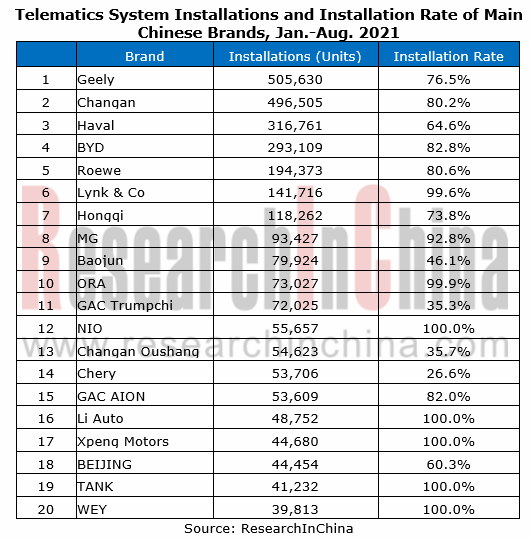
In 2021, local brands in China race to roll out their new-generation telematics systems, highlighting the following:
1. The installation of high computing power master chips in vehicles helps to realize much greater human-computer interaction capability and far better ecological service experience.
The automotive chips developed by Qualcomm, MediaTek, Horizon Robotics, NXP among others have been seen in the telematics systems of Chinese brands. Wherein, the sought-after Qualcomm Snapdragon SA8155P with super computing power so far have found application in mass-produced models including Geely Xingyue L, Lynk & Co 09, AION LX, Haval H6S/Shenshou, WEY Mocha, WEY Macchiato, ORA Cat, and LiXiang P5, Weltmeister W6 and NIO ET7.
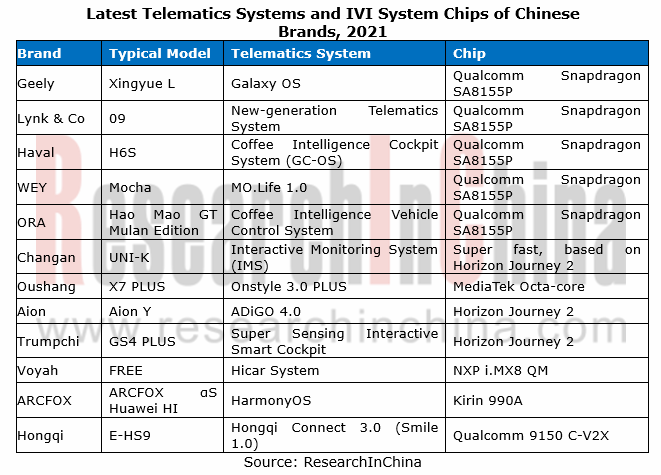
Snapdragon SA8155P, Qualcomm’s 3rd-generation automotive cockpit platform, is powered by 7nm process and octa-core CPU, with computing power ten times greater than the previous 820A, and speeds of CPU and GPU 8.5 times and 20 times faster than the previous generation, respectively. The 8155 chip enables multi-screen display, personalized AI, immersive audio and video, 5G connectivity and other capabilities for a number of models.
Xingyue L: run on Geely Galaxy OS, a new-generation vehicle system co-developed by ECARX and Geely, and use Qualcomm 8155 chip with 105K DMIPS CPU, 1000 GFLPOS GPU and 8 TOPS NPU.
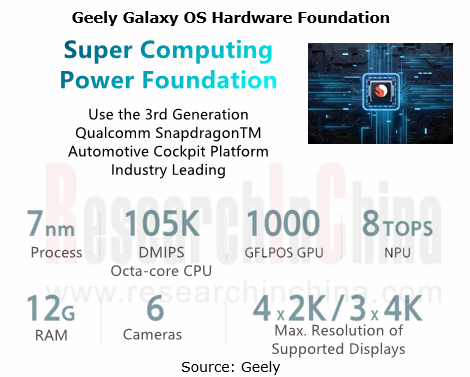
Based on the great hardware foundation, Galaxy OS features four major core capabilities: Human Vehicle Interaction, Intelligent Vehicle Control, Edge AI, and Open Ecosystem.
Human Vehicle Interaction: Xingyue L’s four display systems of AR-HUD, dashboard, center console and co-pilot screen enable cross-screen interaction and multi-finger operation. The triple-screen display design of dashboard, center console and co-pilot screens (all 12.3 inches) allow 1/2/3-finger swipe interaction, of which: 1-inger swipe enables quick switch between controls; 2-finger swipe is for center console display split; 3-finger swipe achieve cross-screen interaction.
Edge AI: the information “preloading” technology is used to enable Baidu Apollo with local voice interaction, voice control over all body functions, human voice control in all scenarios, and 24-hour wake-up-free voice interaction at the driver’s seat, as well as self-learning and self-evolution capabilities.
Intelligent Vehicle Control: support 1,300+ body signal connections and 170+ body control functions; enable 3D rendering effects in control of air conditioner, seats and other functions.
Open Ecosystem: work with partners like Baidu, Tencent and ByteDance to build a vehicle ecosystem with abundant applications of “speaking, listening, watching and playing”, including WeChat vehicle version, Kuwo Music, Ximalaya, Aiquting, Douyin, Bilibili, iQIYI, and National K Songs.
As well as Qualcomm 8155 automotive chip, Horizon Journey 2 also enables multiple models of Changan, GAC and Chery among others, with a range of intelligent functions such as eye sight screen brightening, distraction warning, fatigue monitoring, gesture recognition, and voice-activated photographing.
Changan UNI-K: the latest Interactive Monitoring System (IMS) for this car carries the Super Fast chip developed on Horizon Journey 2. Booted in just 4.7 seconds, the system realizes 3+1 quad-screen interaction and bears iFLYTEK Feiyu OS 3.0 (a voice interaction system), all-domain gesture interaction system, face recognition, fatigue driving warning, and other features. Wherein, the powerful all-domain gesture interaction system allows the driver to use the camera above the interior rearview mirror for gesture-activated song switch, photographing, and navigation to home or office, and also offers gesture control to rear row passengers.
ARCFOX αS Huawei HI: it is the first car to adopt Huawei Kirin 990A chip and HarmonyOS, of which the Kirin 990A chip with 3.5TOPs computing power allows 5G connectivity and enables multi-display integration, face recognition, gesture recognition, four-voice-area voice recognition, 30-second continuous dialogue without wake-up, and car-home interconnection.
Voyah FREE: as the first model launched by Voyah, Dongfeng’s high-end intelligent electric vehicle brand in June 2021, it is based on NXP i.MX8QM and packs the new-generation IVI system co-developed with PATEO and Huawei, which is equipped with a lift type triple-screen integrated display and supports multi-screen interaction and multi-modal interaction (gesture, face, voice, AR navigation, touch, etc.). Soulmate AI intelligent assistant created by PATEO enables four-voice-area voice pickup, multiple rounds of voice dialogue, and active greetings and caring such as congestion prompt, route recommendation, fatigue warning, forgotten child remainder, and last-mile guidance.
2. Partner with BATH to build an all-scenario ecosystem.
In the field of in-vehicle ecosystem, Chinese brands always partner closely with BATH (Baidu, Alibaba, Tencent and Huawei). In 2021, ByteDance (Douyin, Xigua Video, TouTiao, etc.) has joined as well.
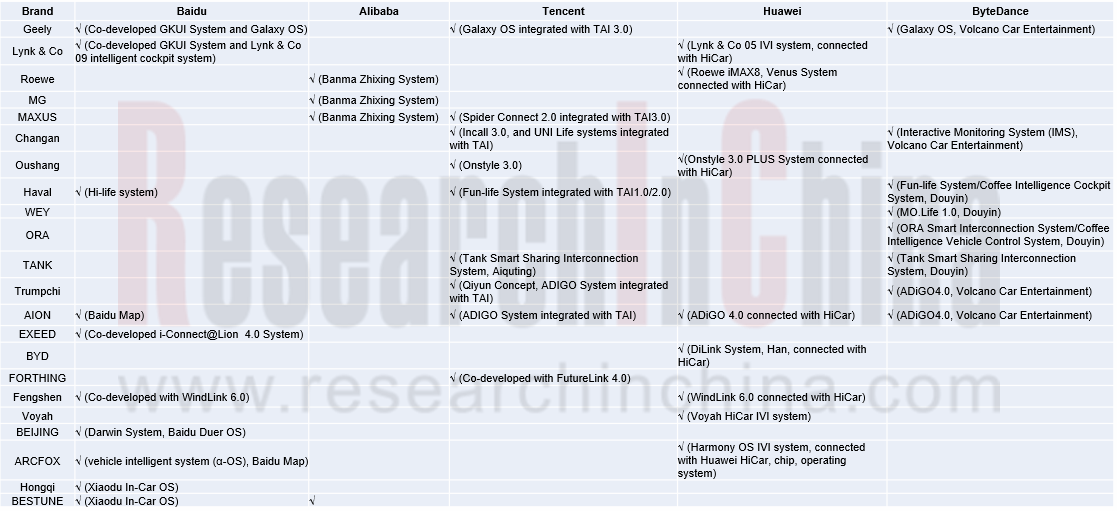
Baidu: Carlife, Xiaodu In-Car OS, etc. have been seen in the latest telematics systems of Haval, Trumpchi, EXEED, Dongfeng Fengshen, Dongfeng Venucia, BEIJING, Hongqi and BESTUNE. For example, EXEED Lion 4.0 that packs Xiaodu In-Car OS and Intel quad-core chip is connected with Baidu’s ecosystem with 300+ services including IQiyi, QQ Music, Ximalaya FM, EXEED Changba, Qingting FM, Car KTV, Suixinkan, Baidu Map, and Smart Parking.
In August 2021, the new-generation intelligent cockpit system co-developed by Baidu and ECARX for Lynk & Co 09 made a debut. For the system, ECARX provides underlying hardware and upper-layer services; Baidu offers voice interaction, vehicle applications and scenario services. The cockpit system allows intelligent integration between people, ambient light and fragrance system according to the vehicle application scenario, for example, actively opening Burning Moment fragrance to help the driver refresh herself/himself if tired driving is detected, and adjusting the ambient light according to the driving mode.
Alibaba: the Banma Zhixing System co-released with SAIC and based on AliOS has been iterated five times so far. The new models like Roewe and MG launched in 2021 are equipped with the VENUS System (Banma Zhixing 4.0), which enables center console interface A/B display, personalized AI image setting and customization, Alibaba’s ecosystem and applets access, and car home interconnection. The ecological services introduced in 2021 include NetEase Cloud Music, Bilibili, Banma Interactive Radio, XUEXI.CN, Tmall Genie, and DingTalk vehicle version.
As AliOS IVI system came into service, Banma Zhixing rolled out OS trilogy in early 2020: Intelligent IVI OS, Intelligent Cockpit OS and Intelligent Vehicle OS; Luoshen OS, a heterogeneous integrated intelligent cockpit system launched with SAIC in October 2021, is about to be available to MG ONE and New Roewe RX5 MAX.
Based on Luoshen OS and Qualcomm Snapdragon 8155, MG ONE’s intelligent cockpit enables cross-display interaction, 0 seconds to boot, and AI semantics driven by Alibaba DAMO Engine, and has the ability to self-learn and self-evolve in seven days. It also meets young consumers’ needs for Bilibili Esport.
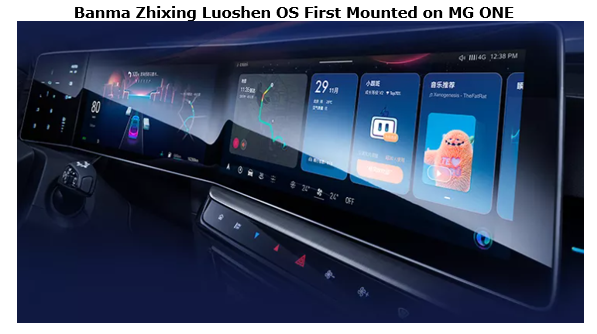
Tencent: the giant has forged partnerships with automakers like Geely, Changan, Haval, Trumpchi and Dongfeng Forthing. Multiple Tencent products including Tencent Map, Tencent Cloud, Xiaowei Voice, and Tencent Auto Intelligence (TAI) System have been connected. TAI 3.0 combines three features: Aiquting (QQ Music, Ximalaya, WeRead, Tencent Video, Pocket Story, etc.), Tencent Suixing (mobility assistant, and one account for mobile phone, IVI system, WeChat vehicle version, etc.), and Tencent Mini Scenario, which have been integrated into Geely Galaxy OS, Dongfeng Forthing Future Link 4.0, SAIC Maxus Spider Connect 2.0 and other systems.
Huawei: using 5G technology, Huawei HiCar System enables people-car-home interconnection in all scenarios, including smartphone integration, one-click navigation, video call, one-click remote home control, fatigue driving monitoring, gesture interaction, and smartphone application ecosystem sharing, and is also connected with 30+ vehicle ecosystems. So far HiCar System has been available to dozens of brands such as Dongfeng Fengshen, Dongfeng Fengon, Voyah, Lynk & Co, GAC Trumpchi, BYD and SAIC Roewe, with over 500 units expected to be pre-installed at the end of this year.
3. 5G has become available to a range of models.
Since 2020 automakers have launched multiple 5G-enabled mass-produced models.
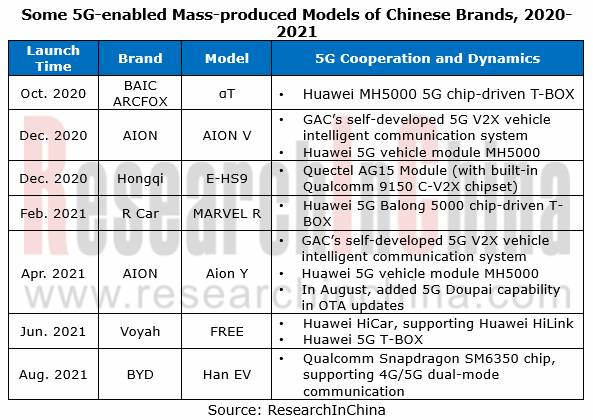
OEMs and Tier 1 Suppliers' Cost Reduction and Efficiency Enhancement Strategy Analysis Report, 2025
ResearchInChina released the "OEMs and Tier 1 Suppliers' Cost Reduction and Efficiency Enhancement Strategy Analysis Report, 2025", summarizing hundreds of cost reduction strategies to provide referen...
Automotive Fixed Panoramic Sunroof and Smart Roof Research Report, 2025
With the intelligent application of car roofs as the core, this report systematically sorts out a series of new products such as fixed panoramic sunroof/openable sunroof, ceiling screen, roof ambient ...
Automotive-Grade Power Semiconductor and Module (SiC, GaN) Industry Research Report, 2025
SiC/GaN Research: Sales volume of 800V+ architecture-based vehicles will increase more than 10 times, and hybrid carbon (SiC+IGBT) power modules are rapidly being deployed in vehicles.
Sales volume o...
Cockpit Agent Engineering Research Report, 2025
Cockpit Agent Engineering Research: Breakthrough from Digital AI to Physical AI
Cockpit Agent Engineering Research Report, 2025 starts with the status quo of cockpit agents, summarizes the technical ...
Prospective Study on L3 Intelligent Driving Technology of OEMs and Tier 1 Suppliers, 2025
L3 Research: The Window of Opportunity Has Arrived - Eight Trends in L3 Layout of OEMs and Tier 1 Suppliers
Through in-depth research on 15 OEMs (including 8 Chinese and 7 foreign OEMs) and 9 Tier 1 ...
China Commercial Vehicle IoV and Intelligent Cockpit Industry Research Report 2025
Commercial Vehicle IoV and Cockpit Research: The Third Wave of Passenger Car/Commercial Vehicle Technology Integration Arrives, and T-Box Integrates e-Call and 15.6-inch for Vehicles
I. The third wav...
Intelligent Vehicle Electronic and Electrical Architecture (EEA) and Technology Supply Chain Construction Strategy Research Report, 2025
E/E Architecture Research: 24 OEMs Deploy Innovative Products from Platform Architectures to Technical Selling Points
According to statistics from ResearchInChina, 802,000 passenger cars with domain...
Research Report on Intelligent Vehicle Cross-Domain Integration Strategies and Innovative Function Scenarios, 2025
Cross-Domain Integration Strategy Research: Automakers' Competition Extends to Cross-Domain Innovative Function Scenarios such as Cockpit-Driving, Powertrain, and Chassis
Cross-domain integration of ...
China Autonomous Driving Data Closed Loop Research Report, 2025
Data Closed-Loop Research: Synthetic Data Accounts for Over 50%, Full-process Automated Toolchain Gradually Implemented
Key Points:From 2023 to 2025, the proportion of synthetic data increased from 2...
Automotive Glass and Smart Glass Research Report, 2025
Automotive Glass Report: Dimmable Glass Offers Active Mode, Penetration Rate Expected to Reach 10% by 2030
ResearchInChina releases the Automotive Glass and Smart Glass Research Report, 2025. This r...
Passenger Car Brake-by-Wire (BBW) Research Report, 2025
Brake-by-Wire: EHB to Be Installed in 12 Million Vehicles in 2025
1. EHB Have Been Installed in over 10 Million Vehicles, A Figure to Hit 12 Million in 2025.
In 2024, the brake-by-wire, Electro-Hydr...
Autonomous Driving Domain Controller and Central Computing Unit (CCU) Industry Report, 2025
Research on Autonomous Driving Domain Controllers: Monthly Penetration Rate Exceeded 30% for the First Time, and 700T+ Ultrahigh-compute Domain Controller Products Are Rapidly Installed in Vehicles
L...
China Automotive Lighting and Ambient Lighting System Research Report, 2025
Automotive Lighting System Research: In 2025H1, Autonomous Driving System (ADS) Marker Lamps Saw an 11-Fold Year-on-Year Growth and the Installation Rate of Automotive LED Lighting Approached 90...
Ecological Domain and Automotive Hardware Expansion Research Report, 2025
ResearchInChina has released the Ecological Domain and Automotive Hardware Expansion Research Report, 2025, which delves into the application of various automotive extended hardware, supplier ecologic...
Automotive Seating Innovation Technology Trend Research Report, 2025
Automotive Seating Research: With Popularization of Comfort Functions, How to Properly "Stack Functions" for Seating?
This report studies the status quo of seating technologies and functions in aspe...
Research Report on Chinese Suppliers’ Overseas Layout of Intelligent Driving, 2025
Research on Overseas Layout of Intelligent Driving: There Are Multiple Challenges in Overseas Layout, and Light-Asset Cooperation with Foreign Suppliers Emerges as the Optimal Solution at Present
20...
High-Voltage Power Supply in New Energy Vehicle (BMS, BDU, Relay, Integrated Battery Box) Research Report, 2025
The high-voltage power supply system is a core component of new energy vehicles. The battery pack serves as the central energy source, with the capacity of power battery affecting the vehicle's range,...
Automotive Radio Frequency System-on-Chip (RF SoC) and Module Research Report, 2025
Automotive RF SoC Research: The Pace of Introducing "Nerve Endings" such as UWB, NTN Satellite Communication, NearLink, and WIFI into Intelligent Vehicles Quickens
RF SoC (Radio Frequency Syst...